

This is where we deal with "system" wide functions. The master course catalog and class setup are at the top.
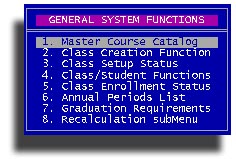
One of the most import things we need to do is create a coherent master course catalog. The master course catalog lists all of the courses your program will offer throughout the year. The courses are grouped into departments and sub-departments or sections. This is done with the numbering system.
The term course refers to a specific body of knowledge, or curriculum, that you may make available to your students (customers). A class, on the other hand, is an instance of a course -- a class entity specifies not only what will be taught (the course), but when, where, and by whom it will be taught, among other attributes.
The Master Course Catalog, as it's name implies, is the list of products (courses) that may be offered to your customers at various times throughout the academic year. The Course Catalog should be organized using a hierarchical numbering scheme, incorporating Department and sub-department placeholders (much like a college numbering system). The following demonstrates this technique:
1000 Business and Computer Department
1100 General Business Section
1121 Office Skills I
1122 Office Skills II
1200 Computer Section
1225 Information Systems
1231 Introduction to Computers
1235 Keyboard Awareness I
1236 Keyboard Awareness II
To help enforce this Department / Sub-Department hierarchy, STURECİ will not let you create a class from any course number that ends in zero(0) -- such course numbers are organizational placeholders used primarily when constructing Graduation Requirements (Grad Sets), for use by the Automatic Credit Analysis. When creating your Course Catalog, keep in mind that you can only receive funding for the first time a student receives credit for a given course, which means that for courses that span enrollment periods, you will have to give it a different number for each enrollment period. For example, if "Freshman English" is a full year course, but you are operating with two semester, then you would create two entries in the Course Catalog: "2101 - Freshman English I", and "2102 - Freshman English II" for example. With different course numbers for each enrollment period, neither STURECİ nor your auditor will complain.
Ok, enough theory, let's get to it! You can Edit or create your course catalog, print the catalog or check the SRSD cross reference codes.
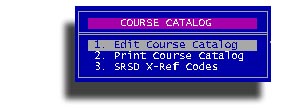
Edit Course Catalog will bring up this panel. Read the messages at the bottom of the screen. Type in the number of the Department you want to work with. Now you have a typical dialog panel where you put in the course code and matching description that will become your course catalog.
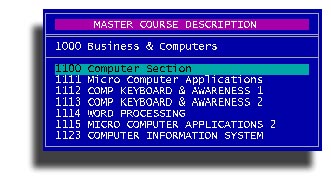
Here are a few important rules regarding department numbers and course codes. The department "0000" or the zero department, is reserved as the Learning Block department and the "9000" department is reserved as the Adult Basic Education Department, only ABE and ESL courses may be setup in the 9000 department. The rest of the departments, 1000 through 8000 are considered High School Completion courses. Only HS Completion courses are appropriate for use in the Learning Block concept, which we will talk about later. GED Preparation courses may be placed in the department relevant to the discipline or in a special department you create just for GED prep courses.
Print Course Catalog should be a no-brainer. Follow the prompts.
SRSD X-Ref Codes. This is simply a dialog for you to view the contents of the SRSD Course Enrollments cross reference file.
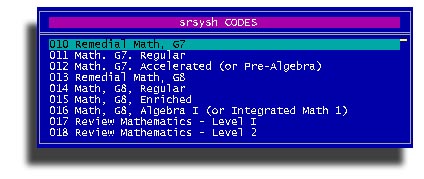
What's this all about? You are required to cross-reference all math and science classes taken by your under 20 alternative students to a selection from this list. STURECİ makes it easy for you. When you create a course (item 1 above) you will be asked for an appropriate SRSD cross-reference code, if required. Well, if the course is a math or science course, it is required! You will choose from this list the code that most closely identifies the course. This is probably something your boss should handle, or consult with some expert in your district. Once you have tied the cross-reference code to the course, STURECİ will insert the correct cross-reference code in the SRSD file when you do your Fall and Spring SRSD file submission. This file is updated and supplied by MicroData Systems, Ltd. from time-to-time as the state may make changes to its contents.
Time to create some classes. The Class Creation Function will be good for this.
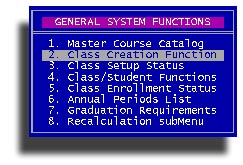

Enter the enrollment period you want to work with then you will see this screen
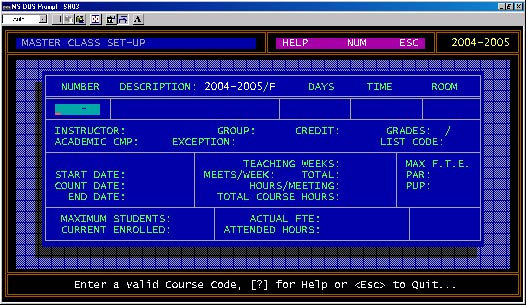
STURECİ uses the term class when referring to an instructional setting and all of it's administrative attributes. This is significantly different than the term
course, which STURECİ uses to identify a specific curriculum (or body of knowledge to be taught).
While the mechanics of entering class setup data into STURECİ are fairly simple, that DOES NOT mean this process can be taken lightly, or done hap-hazardly. Incorrectly configured classes and/or Course
Catalog can cause real problems for you down the road,
possible loss of funding. With a little fore-thought and proper planning, however, the process will be quick and trouble-free.
Dr. Bob's advice: The data-entry person should work from documents containing class schedule/setup
approved by the program director.
Let's analyze what we have.
First section
Second section
Third section
Bottom section
Ok, now how do we do it?
Enter a valid course code (must already be in your Master Course Catalog) and
the name of the course will pop-up. Next enter a section number (may contain
letters) to create a section or instance of this course.
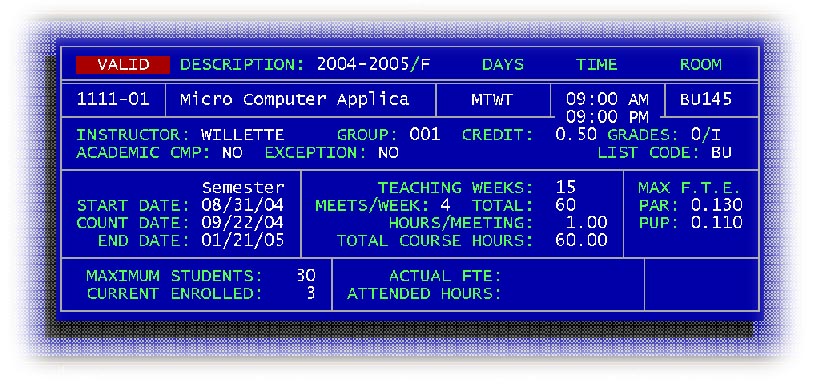
Read the messages at the bottom of the screen. These messages will guide you through the process. Here are all of the data elements you will need to deal with.
The first one is an "IF" question. If you have Alternate Schedules created, you will be asked if you want to apply an alternate schedule to this class. See Alternative Schedules
If you don't have alternate schedules setup, or you choose not to apply an
alternate schedule to this class, you will next be asked
"Please picture the days the class meets by placing appropriate
marks..." 
Remember that STURECİ uses a six day week beginning with Monday and going
through Saturday. Imagine the letters of the days in their ordinate position.
Monday in first position, Tuesday in second, Wednesday in third and so on. You
may place any letter, but it must be in the correct ordinate position of the day
or days that the class will meet. A Monday and Wednesday class would look
like [M W ]
"What time of day does this class begin, when it meets?"

You need to enter leading zeros in the time, example: 09:00 and put either
"A" or "P" or morning or after noon. It would be helpful to
know "When does this class
end?"  Next you will be asked to "Enter a two letter Building
designator and Room Number, or [?] for Help..."
Next you will be asked to "Enter a two letter Building
designator and Room Number, or [?] for Help..."  If
you press the question mark [?], you will be show a list of building codes that
you have already setup. Every class must have a building code, but you may leave
the room number empty if you want.
If
you press the question mark [?], you will be show a list of building codes that
you have already setup. Every class must have a building code, but you may leave
the room number empty if you want.
"Enter the
teacher's last name and first initial in the style (Xxxxxxxx, X.)".
Be consistent! This is the only way STURECİ knows how to link class lists by
teacher name.

"What
Management Group does this class belong to? [?] for Help..."  Remember Management Groups, you set them up in Menu:7.3.3.5. Every class you
setup must belong to a management group, just as every class must meet in a
building. Management Groups are an alternate way to group classes for certain
reports that will be useful to management.
Remember Management Groups, you set them up in Menu:7.3.3.5. Every class you
setup must belong to a management group, just as every class must meet in a
building. Management Groups are an alternate way to group classes for certain
reports that will be useful to management.
Now we need to "Enter the High School Completion Credit; Correct Value is n.nn" Classes that are not in the 9000 department (ABE) may carry HS credit value. Generally the credit is loosely tied to 1 credit per 120 hours of class time, but that may vary by district. Currently there is not any "rule" dictating the ratio of credit granted to hours of class time. The correct value that STURECİ recommends is based on the ratio above.
Next we need to know "How
many INTERIM grades will be recorded? (0,1,2,3)" 
You the option of recording up to 3 INTERIM grade/credit pairs
per class, per enrollment period, in ADDITION TO the "Final" grade/credit. However, only the final grade/credit will be
posted to the student's official transcript. For each class you set up with more than one Interim grade cycles, you may
elect to have the "Final" grade automatically calculated as the average of the interim grades, or the final grade can be
completely independent of the interim grades. Similarly, the final credit value will be the SUM of the interim credit if you
elect to have the Final grade auto-calculated, otherwise it will be independent.
These are the possible combinations
[0] - Final grade/credit only, no Interim grades/credit
[1] - One Interim grade/credit plus Final grade/credit
[2] - Two Interim grades/credit plus Final grade/credit
[3] - Three Interim grades/credit plus Final grade/credit
The "Final" grade/credit can be handled this way
[A] - Average of interim grades and total of credit - for classes with more than
one interim
[I] - Independent of interim grades / credit, you decide - for any type class
Next you will be asked "Will this class be an Academic component of a Learning Block?" Answer No, component classes are created by STURECİ automatically when you register a student into a learning block at enrollment time.
"Is class to be treated as an EXCEPTION class at sign-up time? (Yes/No)". Hey, what is an exception class anyway? An exception class is kind of the STURECİ answer to learning blocks for ABE and ESL classes. You may create an ABE or ESL class (9000 department) and set it up for example, four day per week, Monday thru Thursday evening from 6:00 pm to 9:30 pm. Now a student probably cannot attend all four nights (or would be expected to), but the teacher is there and the room is available. When you register the student into the class, you will be asked which days the student will commit to attend. Maybe they can attend Tuesdays and Thursdays only, so you picture it this way and STURECİ will calculate the FTE values for two days per week instead of four days per week. This saves you setting up four different classes, one for each day that you offer the class. This exception concept is not appropriate for regular high school classes. It may be argued as acceptable for GED prep classes.
"You will be asked to "Enter the COMBINED LIST
code, [?] for Help..."  Combined lists are useful for grouping different classes into a unified or
combined class list for attendance or grade purposes. Do not use a list code
that is the same as a Learning Block section! A list code is automatically
created for each Learning Block section by STURECİ. To use this feature, you
must already have created codes via Menu:7.3.3.4. Combined Lists. You may use
the letters of the alphabet and the numbers, this gives you the potential for up
to 1,296 unique codes - minus the ones used for learning blocks. That should be
enough. Leave the code blank if you don't need to use this feature.
Combined lists are useful for grouping different classes into a unified or
combined class list for attendance or grade purposes. Do not use a list code
that is the same as a Learning Block section! A list code is automatically
created for each Learning Block section by STURECİ. To use this feature, you
must already have created codes via Menu:7.3.3.4. Combined Lists. You may use
the letters of the alphabet and the numbers, this gives you the potential for up
to 1,296 unique codes - minus the ones used for learning blocks. That should be
enough. Leave the code blank if you don't need to use this feature.
Now we are going to do the math. You will be asked to "Enter the number of TEACHING Weeks for this Semester class (11..25)". Note that it says teaching weeks, not calendar weeks. A semester class may be between 11 and 25 teaching weeks in length. Look at the calendar and count the number of weeks that the class will be offered. No fractions, only whole numbers. Once the weeks are entered, STURECİ will calculate total number of class meetings from the number of days per week and the number of teaching weeks.
"Please verify the Total Number of CLASS MEETINGS..." You may need to adjust this. For example, a Tuesday Thursday class, will it meet on Thanksgiving Day? Probably not, so you need to adjust the total number of class meetings. After you verify the total number of meetings you will be asked to
"Enter the Average meeting hours per class MEETING..." Verify the amount of time the class will meet for each meeting. If the time varies, enter the average hours per meeting. Next you will be asked to
"Please verify the TOTAL class Meeting Hours for this enrollment period..." STURECİ will calculate this number from the number of meetings times the average hours per meeting. If you disagree, by all means change the total class hours now! This is the number used to calculate FTE values.
This is what the panel may look like after you have verified the data.  Notice that the FTE values for Participants and Pupils has been calculate from
the total class hours. You cannot directly change the FTE values, but you can adjust
the numbers to arrive at the value you want.
Notice that the FTE values for Participants and Pupils has been calculate from
the total class hours. You cannot directly change the FTE values, but you can adjust
the numbers to arrive at the value you want.
After the numbers have been crunched, you will be asked for the beginning and ending dates for the class. Remember that in the fall semester you probably have a week or two off for Christmas break. Consider this when you put in the ending date. STURECİ will pre-calculate the ending date based on the number of teaching weeks specified after the beginning date. It does not know about vacation time.
The last thing you will be asked is "What is the Maximum number of students allowed in this class?" Be realistic. If you have a large room and it doesn't really matter how many students are in the class, put a large number like 100 or 500. But if it is a small classroom or a class that depends on available equipment such as a computer lab with only 10 computers, you may want to consider using a realistic number. This maximum allowed number in no way limits your enrollment, but when you go to register a student into the class, if it is already filled to capacity, you will be asked what to do. Your options will be to Force enrollment anyway, place the student on a Waiting list or forget it and try another class.
Speaking of Learning Blocks. A Learning Block is the term STURECİ uses to describe an instructional setting where:
Hmmm, sounds an awful lot like "Study Hall", doesn't it? However, unlike a true study hall, Learning Blocks allow students to earn academic credit by demonstrating mastery of approved curriculum under the supervision of a certified instructor. Since the students are engaged in self-paced learning the teacher's role is more of a facilitator than instructor.
In order to simplify the record-keeping for Learning Blocks, STURECİ uses two types of class setup records, which are permanently linked. The Block Header record is used for attendance (and Michigan FTE) and teacher scheduling purposes. Look to the Block Header record to determine:
The Academic Component Record is used for enrollment and grade/transcript purposes. These records are used to not only determine who is signed up for what courses, but also to track students' grades.
Learning Block classes are easy to setup and use in STURECİ, but if not done exactly right, you will cause problems for yourself. On the bright side, as long as you follow a these simple rules when creating your Learning Blocks in STURECİ, you should have no problems:
The Procedure:
Before creating a Learning Block Header Record, you must create appropriate entries in menu:5.1. Master Course Catalog, in the "0" (zero) department, which is reserved for Learning Blocks. Here are some sample entries:
0101 Morning Block
0102 Afternoon Block
0103 Evening Block
Now, lets create a Learning Block Header Record, it is very much the same as a
regular class.
1. Go to menu:5.2.Class Setup Procedure, and specify the current enrollment period.
2. Enter a valid Learning Block code and an absolutely unique Section Number.
3. Press A to add this new class.
4. Press [Enter] to skip the Alternate Schedule code (if offered).
5. Set the meeting days to the day the block is scheduled to meet.
6. Set the starting and ending times for the block. Use regular time and
the AM or PM designator
7. Enter an appropriate building and room.
8. Enter the Instructor's name, and management group.
9. Set the CREDIT value to what each individual Academic Component is worth.
10. This is a LEARNING BLK, but is Not an EXCEPTION class.
11. STURECİ will enter the Section Number as the LIST CODE.
12. Enter the correct number of teaching weeks, hours/meeting, total meetings, and total course hours (teacher
availability).
13. Enter appropriate start and end dates, and maximum students.
14. After verifying the enrollment period, and saving the new class, you are ready to enroll students.
To enroll students in the new Learning Block, follow this procedure:
1. Go into menu:1.Student Enrollment Data, and call up a student.
2. Type CR (Class Related) to access their class schedule
3. Press the plus sign [+] to add a new class
4. Enter the code of the learning block, for example 0101-ZZ
5. After verifying the enrollment date you will be prompted to add Academic Components. You may use any valid course in your catalog, and STURECİ will automatically assign it the same section number as the Learning Block Header. After adding all the required Academic Components, simply press [Esc]. You should now see a check-mark next to each Academic Component. You may add as many Academic Components as appropriate for this student / block combination.
For example, if you might normally run a 1/2 credit HSC class for 60-65 hours per semester and you have a Learning Block set-up for four days a week at 3-1/2 hours per meeting for 18 weeks in the semester, that would be 252 hours per semester or about 63 hours per class. The student could be enrolled in four Academic Components in the Learning Block. The FTE Value for the block would be PUP:0.46, PAR:0.56 and each Academic Component would be worth 0.50 academic credit on their transcript.
Learning Block are NOT appropriate for ABE or ESL classes. By definition all of those classes are Exception
classes.
This function provides a number of reports useful to help you make sure you have everything setup correctly before you begin enrolling students. You have a variety of ways to sort and organize the listings. These reports have to do with the classes and how they are setup.
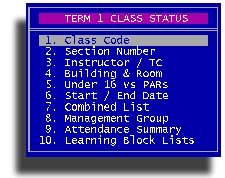
It is a good way to see that you have the correct meeting days, weeks, meetings, begin and end date and so on. Things that are important to your business. We suggest that you run a class status report periodically during the time you are creating classes at the beginning of each semester.
This group of functions are class oriented but will provide information on students as well.
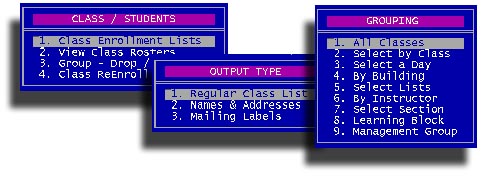
Class Enrollment Lists can be further customized...

View Class Rosters will allow you to view the students in a class, even look at their attendance and grades, but this is not the place to enter or edit anything, just a convenient way to view the rosters without printing.
Group - Drop / Transfer is a powerful helper. With this facility you may go into a Class roster to drop or transfer students on a class-wise basis rather than doing it by individual students. Enter the class code and you will be shown a list of all the students currently registered in the class.
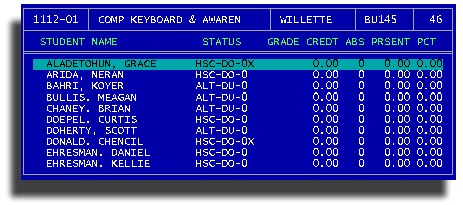
Move the pointer to any student you need, and you may press the minus sign [-] to exit (drop) the student. You will be asked for an appropriate drop or exit reason and a date. Or press the regular slash [/] to mark a student for transfer. When you are finished marking the students, if there are any marked for transfer, you will be asked for the transfer into class. All of the students marked will be transferred into the same target class. If some students will be transferred into different classes, do the operation a second time. This is useful when you have to cancel a class for some reason, but the students still need a class. Transfers are only available within enrollment periods.
Class ReEnroll is used to forward register students from one enrollment period to the next on a group or class-wise basis. It works very much the same as the transfer facility. You must, of course, already have the classes setup for the new semester. This is handy for alternative students that will be enrolling for essentially the same number of classes in the following semester. We recommend that you wait until the end of the first semester before forward enrolling into the next.
You should be able to customize just about any class enrollment status report you may need with this suite of functions.
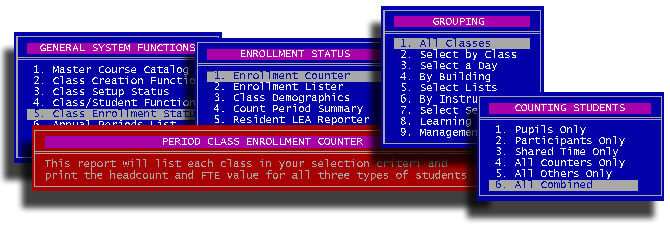
How about listings of actual students?
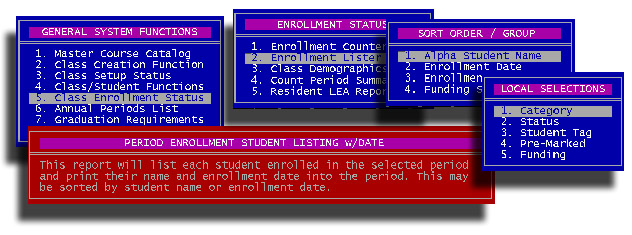
Do you need to report Class Demographics? This should give you fifteen ways from Sunday.

How about a resident LEA report? This should do the trick.
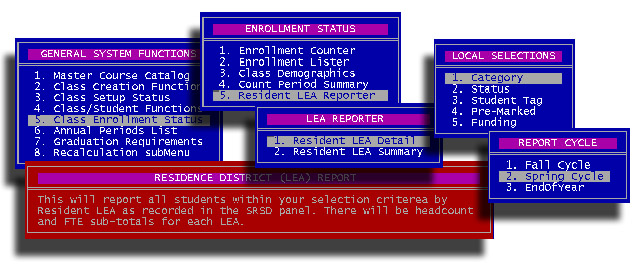
There is one new wrinkle to this residence report, and it is...

This will give you a report of all of the enrollment periods you have setup and a summary of the number of classes setup, students enrolled, hours enrolled and attended, the number completed and the estimated and actual FTE values claimed.

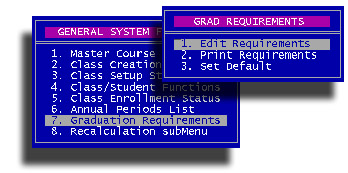
In order to graduate and be awarded a diploma/certificate, students must meet certain criteria, including earned credits (High school). STUREC© can help you identify those students close to graduation, but you must first tell STUREC© what the credit requirements are. The following discussion outlines the basic concepts and procedures for creating graduation requirements (Grad-Sets) that STUREC© can use to accurately analyze a student's progress toward graduation.
First, some terms and definitions:
In theory, performing a Credit Analysis is a simple, straight-forward task; one simply marches thru each requirement, checking the transcript for qualifying entries. For example, if one requirement was 3 credits of English courses, then you would simply tally up the appropriate credits on the student's transcript, and compare the "earned English credits" against the "Required English credits". In actual practice, however, this task can easily fall prey to a variety of human frailties from simple clerical errors (i.e. typos, incomplete paper records), to procedural problems (i.e. inconsistent interpretation and application of requirements). With STUREC©, on the other hand, the automatic credit analysis feature will quickly, tirelessly, consistently, and accurately[1] apply the Grad-Set to all students.
To perform the automatic credit analysis, STUREC© uses a unique pattern-matching algorithm that makes a few assumptions:
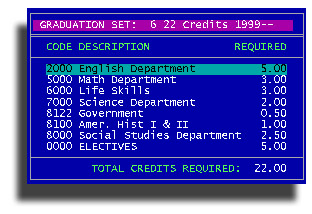
When constructing Grad-Sets, what you are really doing is defining the Course-Number patterns
that best represent your School Board approved graduation requirements. For example, say
that one requirement is that students must have at least 3.5 credits in English courses. If
your Master Course Catalog has the English department listed as 2000, then the Grad-Set entry
would simply read: 2000 English 3.5. STUREC© would then search the student's
transcript for all entries with course numbers that start with 2, and tally the credits.
For broad departments like "Social Studies", the requirements are often more
specific -- like " 0.5 Credits of Government", and "1 full credit of US History".
This situation is easily accommodated by merely adding a significant digit to the patterns which would
give us: 5100 Government 0.5, and 5300 U.S. History 1.0.
To create your own Grad-Sets in STUREC©, go to menu:5.8.1. Edit Requirements. STUREC© will ask for the one-character Grad-Set code that uniquely identifies this Grad-Set, then you may enter a short description. Many schools put the applicable academic year in the Grad-Set's description. Now it's time to add the pattern rules. If this is a new Grad-Set, STUREC© will automatically prompt you for the first requirement. After all four digits are entered (REMEMBER: use zeros as wildcards/placeholders), STUREC© will attempt to find a matchng entry in your Master Course Catalog and fill in the requirement description -- which you may edit as needed. Then, you must specify the minimum total required credits for this pattern. Repeat the process to input all requirements.
When your new Grad-Set is complete, press [Esc] to close the Grad-Set editor and return to the GRAD REQUIREMENTS sub-menu. Now is a good time to select option 3. Set Default to tell STUREC© what Grad-Set to use when performing a Credit Analysis on a student that does not have a specific Grad-Set assigned.
[1] - Credit Analysis is only as accurate as the transcripts and Grad-Set
definitions. Back
[2] - Credit Analysis is virtually useless if like Courses are not grouped numerically. Back
From time to time in an active and dynamic database, such as your STUREC© database, you may need to perform some maintenance. This is one of the menus you need to visit a few times a year.
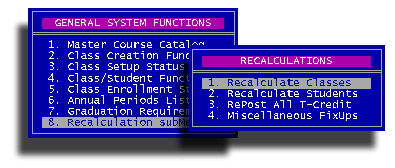
Anytime you make a setup change that affects FTE hours, or the class setup, you
need to perform 1. Recalculate Classes. You will be asked for a semester
and STUREC© will do the rest.
Because some of our students are, shall we say, mobile, you may find it necessary to perform 2. Recalculate Students from time to time.
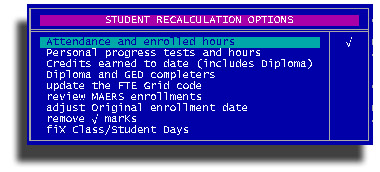
This is a particularly good idea just before you perform some really important
report such as FTE stuff or end of year reports. All of these options can only
help, not do any damage -- except the last one 'fix Class/Student Days', please
don't perform that one unless we suggest that to you. When run improperly, it
could produce unexpected results.
3. Repost All Transcript Credit will re-post locally earned credits to the transcript. First it removes locally earned credits for the selected year then it reposts the credit the same as done in Menu:3.4.Post Transcripts. This is more of a recovery process than maintenance.
4. Miscellaneous FixUps is currently empty, just a place-holder for the future if we need it.